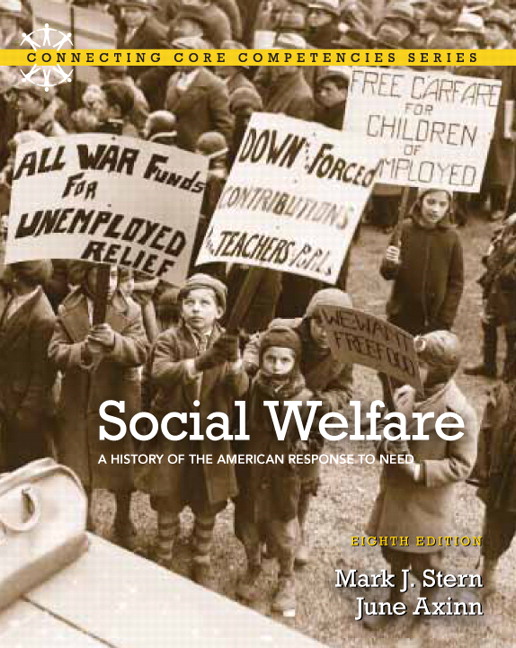Test Bank for Social Welfare: A History of the American Response to Need 8/E 8th Edition Mark J. Stern, June J. Axinn
$35.00 Original price was: $35.00.$26.50Current price is: $26.50.
Test Bank for Social Welfare: A History of the American Response to Need 8/E 8th Edition Mark J. Stern, June J. Axinn
Test Bank for Social Welfare: A History of the American Response to Need 8/E 8th Edition Mark J. Stern, June J. Axinn digital download immediately after payment is complete.

Product details:
- ISBN-10 : 0134449916
- ISBN-13 : 978-0134449913
- Author: Mark Stern
Social Welfare: A History of the American Response to Needenables students to place current issues of social concern in their historical contexts. It examines the comprehensive history of social welfare from the 18th century to the present, while exploring the ideas―as well as the economic and political forces―that have shaped policy development. Using numerous original documentsto provide a clearer picture of historical periods, the authors show how social conditions, ideas about dependency and poverty, and institutions have shaped social policy and the efforts of voluntary organizations and individuals who work with at-risk populations.
This book is part of the Connecting Core Competencies Series, which helps students understand and master CSWE’s core competencies with a variety of learning aids that highlight competency content and critical-thinking questions for the competencies.
Table contents:
1. Introduction: How to Think About Social Welfare’s Past (and Present)
DOCUMENT: Introduction
An Act for the Relief of the Poor, 43 Elizabeth, 1601
2. The Colonial Period: 1647 – 1776
The Poor Laws in the Colonies
Conquest, Expansion, and Population Growth: Native Americans, Immigration, and Slavery
Social Change and the Challenge to the Poor Laws
Veterans: A Special Class
DOCUMENTS: The Colonial Period
An Act of Supplement to the Acts Referring to the Poor, Massachusetts Bay, 1692
The Binding of Moses Love, 1747
3. The Pre-Civil War Period: 1777 – 1860
Social and Economic Conditions
Population Growth and Migration
Slavery and Free Labor
Reform and Social Change
Labor Unrest
Religious Reform and Jacksonian Democracy
The Expansion of Public Education
The Expansion of Suffrage
Moral Reform
Social Welfare Programs and Services
Institutionalization
Child Saving
Retreat from the Almshouse
DOCUMENTS: The Pre-Civil War Period
The First Annual Report of the Managers of the Society for the Prevention of Pauperism in the City of New York, 1818
Constitution, By-Laws, &c., of the Female Orphan Asylum of Portland, Maine, 1828
President Franklin Pierce: Veto Message — An Act Making a Grant of Public Lands to the Several States for the Benefit of Indigent Insane Persons, 1854
4. The Civil War and After: 1860 – 1900
Changing Economic and Demographic Realities
Population Changes
Naturalization and Citizenship
Regional Shifts
The Aging: The Group That Was Left Behind
Innovations in Social Welfare Services
The Welfare of Soldiers and Veterans
Social Welfare: Reconstruction and the Freedmen’s Bureau
Social Welfare and Urban Expansion
The Charity Organization Movement
The Settlement House Movement
A New View of Child Welfare
Social Movements During the Late 19th Century: The Reform Impulse
The Social Welfare of Women
The Labor Movement
The Agrarian Movement
Conclusion
DOCUMENTS: The Civil War and After
An Act to Provide for the Relief of Indigent Soldiers, Sailors and Marines, and the Families of Those Deceased, 1887
The Economic and Moral Effects of Public Outdoor Relief, 1890
An Act to Prohibit the Coming of Chinese Laborers to the United States, September 1888, and Supplement, October 1888
5. Progress and Reform: 1900 – 1930
Changing Economic and Demographic Realities
An Urban and Industrial Society
Poverty and the Working Class
African Americans, Native Americans, and Immigrants
Innovations in Social Welfare
Regulating Working Conditions
Expanding Public Welfare
Protecting Vulnerable Families
Social Work and the Black Population
The Social Welfare of Veterans
Professionalizing Social Work
Social Movements in the Early 20th Century
Coalitions for Reform
Regulating Business
Organized Labor
Women, Work, and Suffrage
The End of Reform
DOCUMENTS: Progress and Reform
The Family and the Woman’s Wage, 1909
Funds to Parents Act, Illinois, 1911
Public Pensions to Widows, 1912
6. The Depression and the New Deal: 1930 – 1940
Changing Economic and Demographic Realities
The Economic Collapse
Agricultural Crisis
Family Life
Innovations in Social Welfare
The Hoover Response to Crisis
FDR and the First New Deal
Public Money for Relief
Federal Emergency Relief Administration (FERA)
The Second New Deal
The Social Security Act
Expanding Social Security: The 1939 Amendments
Public Assistance
The Changing Role of the Social Work Profession
New Alignments in Social Welfare
Mass Movements During the 1930s
Veterans and the Bonus
Older Americans
Labor and Social Welfare
Setbacks for Women
The Eclipse of Reform
Conclusion
DOCUMENTS: The Depression and the New Deal
Monthly Reports of the Federal Emergency Relief Administration, 1933
Social Security Act, 1935
7. War and Prosperity: 1940 – 1968
Changing Economic and Demographic Realities
Population Shifts
Technology, Productivity, and Economic Insecurity
World War II
Wartime Economic and Social Advances
Postwar Optimism
Innovations in Social Welfare
Veterans and the GI Bill
The Attack on Public Welfare
Poverty and the Reform of Welfare
The War on Poverty
Expanded Benefits for the Aging
Controlling Public Assistance
Social Movements and Reform After World War II
Expanding the Civil Rights of African Americans
A Renewed Feminist Movement
Civil Rights and Juvenile Justice
DOCUMENTS: War and Prosperity
Message on the Public Welfare Program, 1962
Economic Opportunity Act, 1964
In re Gault, 1967
8. Conservative Resurgence and Social Change: 1968 – 1992
Economic and Social Trends
A Struggling Economy
Changing Employment Patterns
The Changing Family
Poverty and Income Distribution
Innovations in Social Welfare
Expenditures for Social Welfare
Challenging the Welfare State: Welfare Reform
Child Welfare and the Aging
The Unemployed
Veterans
Personal Social Services
Social Movements
The New Right
The Expansion of Civil Rights
Women
Conclusion
DOCUMENTS: Conservative Resurgence and Social Change
Message on Reform in Welfare, 1969
Standard of Review for Termination of Disability Benefits, 1984
9. Social Welfare and the Information Society: 1992 – 2016
Social and Economic Change
The Economy: Productivity, Growth, and Employment
Poverty
Changes in Family Composition
America’s Changing Demography
Innovations in Social Welfare
The Fall and Rise of Health Care Reform
The Failure of Comprehensive Reform in the 1990s
Achieving Comprehensive Reform in 2010
Addressing Poverty and Dependency: The Scope of Welfare Reform
The Changing Dynamics of the Welfare Debate
The New Consensus over Welfare Reform
The Impact of Welfare Reform
Social Movements and Grassroots Change
Welfare Reform and “Immigration Control”
The Return to Voluntarism and the Rise of Privatization
The Continuing Battle for Social Justice
Education
Affirmative Action in the Labor Market
Abortion and the Right to Privacy
The Great Lockup
Conclusion
DOCUMENTS: Social Welfare and the Information Society
Personal Responsibility and Work Opportunity Reconciliation Act, 1996
State of California, Proposition 187, Illegal Aliens — Public Services, Verification, and Reporting, 1994
U.S. Supreme Court Lawrence v. Texas, 2003
People also search:
a new history of social welfare 8th edition
american social welfare policy 8th edition
social welfare 8th class results
dimensions of social welfare policy 8th edition
Related products
Test Bank
Test Bank for Operating Systems: Internals and Design Principles, 7th Edition: William Stallings











